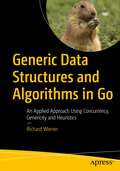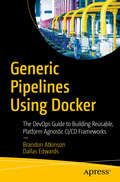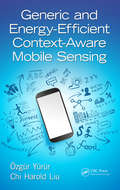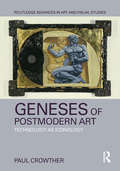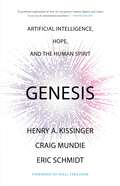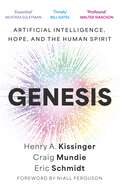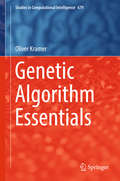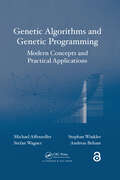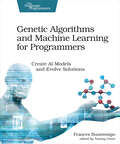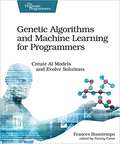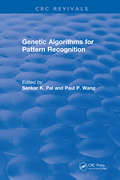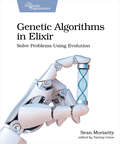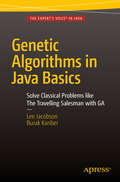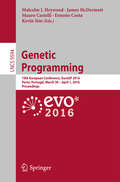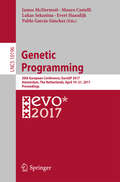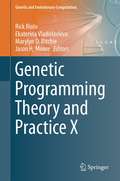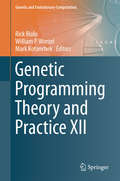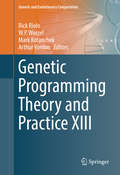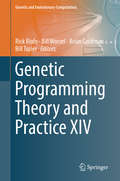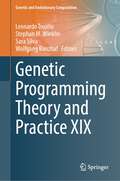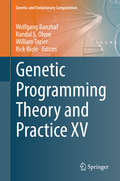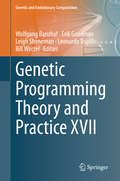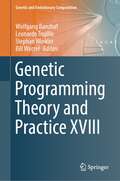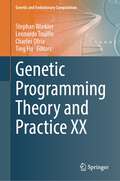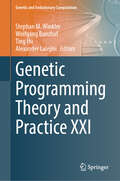- Table View
- List View
Generic Data Structures and Algorithms in Go: An Applied Approach Using Concurrency, Genericity and Heuristics
by Richard WienerAdvance your understanding of generic data structures and algorithms and their applications using Go and the effective use of concurrency. You are invited on a journey that aims to improve your programming and problem-solving skills. This book takes you to the next step by showing how to get your programs to work efficiently as well as correctly. As you explore many data structures and the algorithms and applications associated with them, you'll focus on the trade-offs between speed and storage and the benefits of deploying concurrency when appropriate. This book will demonstrate the huge increases in application performance that are possible. The presentation of classic data structures and techniques of algorithm design (greedy, divide and conquer, branch-and-bound to name a few) provides an essential foundation and toolkit for problem solving. But this book goes further by presenting heuristic algorithms and their implementations for solving computationally intractable combinatoric optimization problems such as the travelling salesperson problem. Simulated annealing and genetic algorithms are among the techniques used.The consistent style of coding used throughout this book exploits Go’s ability to implement abstract, generic and constrained generic data types without the use of classes. Although some familiarity with Go is assumed, this book should advance your ability to use Go to tackle server-side applications, games, machine learning, information retrieval and other application domains where speed and storage efficiency is essential.What You'll LearnExplore classical data structures and algorithms aimed at making your applications run faster or require less storageUse the new generic features of Go to build reusable data structuresUtilize concurrency for maximizing application performanceSee the power of heuristic algorithms for computationally intractable problemsEnhance and improve your Go programming skillsWho This Book Is ForPracticing Go software developers and students who wish to advance their programming and problem-solving skills and experience the excitement and see the benefits of using generic data structures and algorithms that utilize concurrency whenever possible.
Generic Pipelines Using Docker: The DevOps Guide to Building Reusable, Platform Agnostic CI/CD Frameworks
by Brandon Atkinson Dallas EdwardsCreate generic pipelines to reduce your overall DevOps workload and allow your team to deliver faster. This book helps you get up to speed on the pros and cons of generic pipeline methodology, and learn to combine shell scripts and Docker to build generic pipelines.In today’s world of micro-services and agile practices, DevOps teams need to move as fast as feature teams. This can be extremely challenging if you’re creating multiple pipelines per application or tech stack. What if your feature teams could utilize a generic pipeline that could build, test, and deploy any application, regardless of tech stack? What if that pipeline was also cloud and platform agnostic? Too good to be true? Well think again! Generic Pipelines Using Docker explores the principles and implementations that allow you to do just that. You will learn from real-world examples and reusable code. After reading this book you will have the knowledge to build generic pipelines that any team can use. What You'll Learn Explore the pros and cons of generic pipeline methodologyCombine shell scripts and Docker to build a generic pipelineImplement a pipeline across CI/CD platformsBuild a pipeline that lends itself well to both centralized and federated DevOps teamsConstruct a modular pipeline with components that can be added, removed, or replaced as needed Who This Book Is ForProfessionals who use DevOps or are part of a DevOps team, and are seeking ways to streamline their pipelines and drive more deployments while using less code
Generic and Energy-Efficient Context-Aware Mobile Sensing
by Chi Harold Liu Ozgur YururElaborating on the concept of context awareness, this book presents up-to-date research and novel framework designs for context-aware mobile sensing. Generic and Energy-Efficient Context-Aware Mobile Sensing proposes novel context-inferring algorithms and generic framework designs that can help readers enhance existing tradeoffs in mobile sensing,
Geneses of Postmodern Art: Technology As Iconology (Routledge Advances in Art and Visual Studies)
by Paul CrowtherPostmodernism in the visual arts is not just another 'ism.' It emerged in the 1960s as a transformation of artistic creativity inspired by Duchamp's idea that the artwork does not have to be physically made by its creator. Products of mass culture and technology can be used just as well as traditional media. This idea became influential because of a widespread naturalization of technology - where technology becomes something lived in as well as used. Postmodern art embodies this attitude. To explain why, Paul Crowther investigates topics such as eclecticism, the sublime, deconstruction in art and philosophy, and Paolozzi's Wittgenstein-inspired works.
Genesis: Artificial Intelligence, Hope, and the Human Spirit
by Henry A. Kissinger Eric Schmidt Craig MundieIn his final book, the late Henry Kissinger joins forces with two leading technologists to mount &“a profound exploration&” (Walter Isaacson) of the epochal challenges and opportunities presented by the revolution in Artificial Intelligence: a breakthrough that dramatically empowers people in all walks of life while also raising urgent questions about the future of humanity. As it absorbs data, gains agency, and intermediates between humans and reality, AI (Artificial Intelligence) will help us to address enormous crises, from climate change to geopolitical conflicts to income inequality. It might well solve some of the greatest mysteries of our universe and elevate the human spirit to unimaginable heights. But it will also pose challenges on a scale and of an intensity that we have never seen—usurping our power of independent judgment and action, testing our relationship with the divine, and perhaps even spurring a new phase in human evolution. The last book of elder statesman Henry Kissinger, written with technologists Craig Mundie and Eric Schmidt, Genesis charts a course between blind faith and unjustified fear as it outlines an effective strategy for navigating the age of AI.
Genesis: Artificial Intelligence, Hope, and the Human Spirit
by Henry A. Kissinger Eric Schmidt Craig MundieTHE FOLLOW UP TO THE INTERNATIONAL BESTSELLER THE AGE OF AI In his final book, the late Henry Kissinger joins forces with two leading technologists to mount a profound exploration of the epochal challenges and opportunities presented by the revolution in Artificial Intelligence.As it absorbs data, gains agency, and intermediates between humans and reality, AI (Artificial Intelligence) will help us to address enormous crises, from climate change to geopolitical conflicts to income inequality. It might well solve some of the greatest mysteries of our universe and elevate the human spirit to unimaginable heights. But it will also pose challenges on a scale and of an intensity that we have never seen - usurping our power of independent judgment and action, testing our relationship with the divine, and perhaps even spurring a new phase in human evolution.The last book of elder statesman Henry Kissinger, written with technologists Craig Mundie and Eric Schmidt, Genesis charts a course between blind faith and unjustified fear as it outlines an effective strategy for navigating the age of AI.
Genetic Algorithm Essentials
by Oliver KramerThis book introduces readers to genetic algorithms (GAs) with an emphasis on making the concepts, algorithms, and applications discussed as easy to understand as possible. Further, it avoids a great deal of formalisms and thus opens the subject to a broader audience in comparison to manuscripts overloaded by notations and equations. The book is divided into three parts, the first of which provides an introduction to GAs, starting with basic concepts like evolutionary operators and continuing with an overview of strategies for tuning and controlling parameters. In turn, the second part focuses on solution space variants like multimodal, constrained, and multi-objective solution spaces. Lastly, the third part briefly introduces theoretical tools for GAs, the intersections and hybridizations with machine learning, and highlights selected promising applications.
Genetic Algorithms and Genetic Programming: Modern Concepts and Practical Applications (Numerical Insights)
by Stefan Wagner Stephan Winkler Michael Affenzeller Andreas BehamGenetic Algorithms and Genetic Programming: Modern Concepts and Practical Applications discusses algorithmic developments in the context of genetic algorithms (GAs) and genetic programming (GP). It applies the algorithms to significant combinatorial optimization problems and describes structure identification using HeuristicLab as a platform for al
Genetic Algorithms and Machine Learning for Programmers
by Frances BuontempoSelf-driving cars, natural language recognition, and online recommendation engines are all possible thanks to Machine Learning. Now you can create your own genetic algorithms, nature-inspired swarms, Monte Carlo simulations, cellular automata, and clusters. Learn how to test your ML code and dive into even more advanced topics. If you are a beginner-to-intermediate programmer keen to understand machine learning, this book is for you. Discover machine learning algorithms using a handful of self-contained recipes. Build a repertoire of algorithms, discovering terms and approaches that apply generally. Bake intelligence into your algorithms, guiding them to discover good solutions to problems. In this book, you will: Use heuristics and design fitness functions.Build genetic algorithms.Make nature-inspired swarms with ants, bees and particles.Create Monte Carlo simulations.Investigate cellular automata.Find minima and maxima, using hill climbing and simulated annealing.Try selection methods, including tournament and roulette wheels.Learn about heuristics, fitness functions, metrics, and clusters. Test your code and get inspired to try new problems. Work through scenarios to code your way out of a paper bag; an important skill for any competent programmer. See how the algorithms explore and learn by creating visualizations of each problem. Get inspired to design your own machine learning projects and become familiar with the jargon. What You Need: Code in C++ (>= C++11), Python (2.x or 3.x) and JavaScript (using the HTML5 canvas). Also uses matplotlib and some open source libraries, including SFML, Catch and Cosmic-Ray. These plotting and testing libraries are not required but their use will give you a fuller experience. Armed with just a text editor and compiler/interpreter for your language of choice you can still code along from the general algorithm descriptions.
Genetic Algorithms and Machine Learning for Programmers: Create AI Models and Evolve Solutions
by Frances BuontempoSelf-driving cars, natural language recognition, and online recommendation engines are all possible thanks to Machine Learning. Now you can create your own genetic algorithms, nature-inspired swarms, Monte Carlo simulations, cellular automata, and clusters. Learn how to test your ML code and dive into even more advanced topics. If you are a beginner-to-intermediate programmer keen to understand machine learning, this book is for you. <P><P> Discover machine learning algorithms using a handful of self-contained recipes. Build a repertoire of algorithms, discovering terms and approaches that apply generally. Bake intelligence into your algorithms, guiding them to discover good solutions to problems.
Genetic Algorithms for Pattern Recognition (CRC Press Revivals)
by Sankar K. Pal Paul P. WangSolving pattern recognition problems involves an enormous amount of computational effort. By applying genetic algorithms - a computational method based on the way chromosomes in DNA recombine - these problems are more efficiently and more accurately solved. Genetic Algorithms for Pattern Recognition covers a broad range of applications in science and technology, describing the integration of genetic algorithms in pattern recognition and machine learning problems to build intelligent recognition systems. The articles, written by leading experts from around the world, accomplish several objectives: they provide insight into the theory of genetic algorithms; they develop pattern recognition theory in light of genetic algorithms; and they illustrate applications in artificial neural networks and fuzzy logic. The cross-sectional view of current research presented in Genetic Algorithms for Pattern Recognition makes it a unique text, ideal for graduate students and researchers.
Genetic Algorithms in Elixir: Solve Problems Using Evolution
by Sean MoriarityFrom finance to artificial intelligence, genetic algorithms are a powerful tool with a wide array of applications. But you don't need an exotic new language or framework to get started; you can learn about genetic algorithms in a language you're already familiar with. Join us for an in-depth look at the algorithms, techniques, and methods that go into writing a genetic algorithm. From introductory problems to real-world applications, you'll learn the underlying principles of problem solving using genetic algorithms. Evolutionary algorithms are a unique and often overlooked subset of machine learning and artificial intelligence. Because of this, most of the available resources are outdated or too academic in nature, and none of them are made with Elixir programmers in mind. Start from the ground up with genetic algorithms in a language you are familiar with. Discover the power of genetic algorithms through simple solutions to challenging problems. Use Elixir features to write genetic algorithms that are concise and idiomatic. Learn the complete life cycle of solving a problem using genetic algorithms. Understand the different techniques and fine-tuning required to solve a wide array of problems. Plan, test, analyze, and visualize your genetic algorithms with real-world applications. Open your eyes to a unique and powerful field - without having to learn a new language or framework. What You Need: You'll need a macOS, Windows, or Linux distribution with an up-to-date Elixir installation.
Genetic Algorithms in Java Basics
by Lee Jacobson Burak KanberGenetic Algorithms in Java Basics is a brief introduction to solving problems using genetic algorithms, with working projects and solutions written in the Java programming language. This brief book will guide you step-by-step through various implementations of genetic algorithms and some of their common applications, with the aim to give you a practical understanding allowing you to solve your own unique, individual problems. After reading this book you will be comfortable with the language specific issues and concepts involved with genetic algorithms and you'll have everything you need to start building your own. Genetic algorithms are frequently used to solve highly complex real world problems and with this book you too can harness their problem solving capabilities. Understanding how to utilize and implement genetic algorithms is an essential tool in any respected software developers toolkit. So step into this intriguing topic and learn how you too can improve your software with genetic algorithms, and see real Java code at work which you can develop further for your own projects and research. Guides you through the theory behind genetic algorithms Explains how genetic algorithms can be used for software developers trying to solve a range of problems Provides a step-by-step guide to implementing genetic algorithms in Java What you'll learn How to construct genetic algorithms in Java which you can extend for your own projects and research What genetic algorithms are and the biological inspiration behind them How genetic algorithms can be implemented to solve problems Solving a traveling salesman problem and how to apply a genetic algorithm to it How to use a genetic algorithm to solve timetabling problems How a genetic algorithm can be used to build a robotic controller Applying optimization techniques to genetic algorithms Who this book is for Genetic Algorithms in Java Basics is perfect for developers, researchers and students who are working on problems where genetic algorithms may be a solution and need to program real, working code in Java. It's also suitable for all Java developers who are curious about genetic algorithms who would like a practical, hands-on introduction to genetic algorithms using Java. Table of Contents 1. Introduction 2. Implementation of a Basic Algorithm 3. Robot Controllers 4. Traveling 5. Class Scheduling 6. Optimization
Genetic Programming
by Malcolm I. Heywood James Mcdermott Mauro Castelli Kevin Sim Ernesto CostaThis book constitutes the refereed proceedings of the19th European Conference on Genetic Programming, EuroGP 2016, held in Porto,Portugal, in March/April 2016 co-located with the Evo*2016 events: EvoCOP,EvoMUSART, and EvoApplications. The 11 revised full papers presented togetherwith 8 poster papers were carefully reviewed and selected from 36 submissions. The wide range of topics in this volume reflects the current state of researchin the field. Thus, we see topics as diverse as semantic methods, recursiveprograms, grammatical methods, coevolution, Cartesian GP, feature selection,metaheuristics, evolvability, and fitness predictors; and applicationsincluding image processing, one-class classification, SQL injection attacks,numerical modelling, streaming data classification, creation and optimisationof circuits, multi-class classification, scheduling in manufacturing andwireless networks.
Genetic Programming
by James Mcdermott Mauro Castelli Pablo García-Sánchez Lukas Sekanina Evert HaasdijkThis book constitutes the refereed proceedings of the 18th European Conference on Genetic Programming, EuroGP 2015, held in Copenhagen, Spain, in April 2015 co-located with the Evo 2015 events, EvoCOP, Evo MUSART and Evo Applications. The 12 revised full papers presented together with 6 poster papers were carefully reviewed and selected form 36 submissions. The wide range of topics in this volume reflects the current state of research in the field. Thus, we see topics as diverse as semantic methods, recursive programs, grammatical methods, coevolution, Cartesian GP, feature selection, initialisation procedures, ensemble methods and search objectives; and applications including text processing, cryptography, numerical modelling, software parallelisation, creation and optimisation of circuits, multi-class classification, scheduling and artificial intelligence.
Genetic Programming Theory and Practice X
by Ekaterina Vladislavleva Marylyn D Ritchie Jason H. Moore Rick RioloThese contributions, written by the foremost international researchers and practitioners of Genetic Programming (GP), explore the synergy between theoretical and empirical results on real-world problems, producing a comprehensive view of the state of the art in GP. Topics in this volume include: evolutionary constraints, relaxation of selection mechanisms, diversity preservation strategies, flexing fitness evaluation, evolution in dynamic environments, multi-objective and multi-modal selection, foundations of evolvability, evolvable and adaptive evolutionary operators, foundation of injecting expert knowledge in evolutionary search, analysis of problem difficulty and required GP algorithm complexity, foundations in running GP on the cloud - communication, cooperation, flexible implementation, and ensemble methods. Additional focal points for GP symbolic regression are: (1) The need to guarantee convergence to solutions in the function discovery mode; (2) Issues on model validation; (3) The need for model analysis workflows for insight generation based on generated GP solutions - model exploration, visualization, variable selection, dimensionality analysis; (4) Issues in combining different types of data. Readers will discover large-scale, real-world applications of GP to a variety of problem domains via in-depth presentations of the latest and most significant results.
Genetic Programming Theory and Practice XII
by Rick Riolo William P. Worzel Mark KotanchekThese contributions, written by the foremost international researchers and practitioners of Genetic Programming (GP), explore the synergy between theoretical and empirical results on real-world problems, producing a comprehensive view of the state of the art in GP. Topics in this volume include: gene expression regulation, novel genetic models for glaucoma, inheritable epigenetics, combinators in genetic programming, sequential symbolic regression, system dynamics, sliding window symbolic regression, large feature problems, alignment in the error space, HUMIE winners, Boolean multiplexer function, and highly distributed genetic programming systems. Application areas include chemical process control, circuit design, financial data mining and bioinformatics. Readers will discover large-scale, real-world applications of GP to a variety of problem domains via in-depth presentations of the latest and most significant results.
Genetic Programming Theory and Practice XIII
by Rick Riolo Arthur Kordon Mark Kotanchek W. P. WorzelThese contributions, written by the foremost international researchers and practitioners of Genetic Programming (GP), explore the synergy between theoretical and empirical results on real-world problems, producing a comprehensive view of the state of the art in GP. Topics in this volume include: multi-objective genetic programming, learning heuristics, Kaizen programming, Evolution of Everything (EvE), lexicase selection, behavioral program synthesis, symbolic regression with noisy training data, graph databases, and multidimensional clustering. It also covers several chapters on best practices and lesson learned from hands-on experience. Additional application areas include financial operations, genetic analysis, and predicting product choice. Readers will discover large-scale, real-world applications of GP to a variety of problem domains via in-depth presentations of the latest and most significant results.
Genetic Programming Theory and Practice XIV (Genetic and Evolutionary Computation)
by Rick Riolo Bill Worzel Brian Goldman Bill TozierThese contributions, written by the foremost international researchers and practitioners of Genetic Programming (GP), explore the synergy between theoretical and empirical results on real-world problems, producing a comprehensive view of the state of the art in GP. Chapters in this volume include: Similarity-based Analysis of Population Dynamics in GP Performing Symbolic RegressionHybrid Structural and Behavioral Diversity Methods in GPMulti-Population Competitive Coevolution for Anticipation of Tax EvasionEvolving Artificial General Intelligence for Video Game ControllersA Detailed Analysis of a PushGP RunLinear Genomes for Structured ProgramsNeutrality, Robustness, and Evolvability in GPLocal Search in GPPRETSL: Distributed Probabilistic Rule Evolution for Time-Series ClassificationRelational Structure in Program Synthesis Problems with Analogical ReasoningAn Evolutionary Algorithm for Big Data Multi-Class Classification ProblemsA Generic Framework for Building Dispersion Operators in the Semantic SpaceAssisting Asset Model Development with Evolutionary AugmentationBuilding Blocks of Machine Learning Pipelines for Initialization of a Data Science Automation Tool Readers will discover large-scale, real-world applications of GP to a variety of problem domains via in-depth presentations of the latest and most significant results.
Genetic Programming Theory and Practice XIX (Genetic and Evolutionary Computation)
by Leonardo Trujillo Wolfgang Banzhaf Sara Silva Stephan M. WinklerThis book brings together some of the most impactful researchers in the field of Genetic Programming (GP), each one working on unique and interesting intersections of theoretical development and practical applications of this evolutionary-based machine learning paradigm. Topics of particular interest for this year´s book include powerful modeling techniques through GP-based symbolic regression, novel selection mechanisms that help guide the evolutionary process, modular approaches to GP, and applications in cybersecurity, biomedicine and program synthesis, as well as papers by practitioner of GP that focus on usability and real-world results. In summary, readers will get a glimpse of the current state of the art in GP research.
Genetic Programming Theory and Practice XV (Genetic and Evolutionary Computation)
by Rick Riolo Wolfgang Banzhaf Randal S. Olson William TozierThese contributions, written by the foremost international researchers and practitioners of Genetic Programming (GP), explore the synergy between theoretical and empirical results on real-world problems, producing a comprehensive view of the state of the art in GP. Topics in this volume include: exploiting subprograms in genetic programming, schema frequencies in GP, Accessible AI, GP for Big Data, lexicase selection, symbolic regression techniques, co-evolution of GP and LCS, and applying ecological principles to GP. It also covers several chapters on best practices and lessons learned from hands-on experience. Readers will discover large-scale, real-world applications of GP to a variety of problem domains via in-depth presentations of the latest and most significant results.
Genetic Programming Theory and Practice XVII (Genetic and Evolutionary Computation)
by Leonardo Trujillo Wolfgang Banzhaf Bill Worzel Leigh Sheneman Erik GoodmanThese contributions, written by the foremost international researchers and practitioners of Genetic Programming (GP), explore the synergy between theoretical and empirical results on real-world problems, producing a comprehensive view of the state of the art in GP. In this year’s edition, the topics covered include many of the most important issues and research questions in the field, such as: opportune application domains for GP-based methods, game playing and co-evolutionary search, symbolic regression and efficient learning strategies, encodings and representations for GP, schema theorems, and new selection mechanisms.The volume includes several chapters on best practices and lessons learned from hands-on experience. Readers will discover large-scale, real-world applications of GP to a variety of problem domains via in-depth presentations of the latest and most significant results.
Genetic Programming Theory and Practice XVIII (Genetic and Evolutionary Computation)
by Leonardo Trujillo Wolfgang Banzhaf Bill Worzel Stephan WinklerThis book, written by the foremost international researchers and practitioners of genetic programming (GP), explores the synergy between theoretical and empirical results on real-world problems, producing a comprehensive view of the state of the art in GP. In this year’s edition, the topics covered include many of the most important issues and research questions in the field, such as opportune application domains for GP-based methods, game playing and co-evolutionary search, symbolic regression and efficient learning strategies, encodings and representations for GP, schema theorems, and new selection mechanisms. The book includes several chapters on best practices and lessons learned from hands-on experience. Readers will discover large-scale, real-world applications of GP to a variety of problem domains via in-depth presentations of the latest and most significant results.
Genetic Programming Theory and Practice XX (Genetic and Evolutionary Computation)
by Leonardo Trujillo Ting Hu Charles Ofria Stephan WinklerGenetic Programming Theory and Practice brings together some of the most impactful researchers in the field of Genetic Programming (GP), each one working on unique and interesting intersections of theoretical development and practical applications of this evolutionary-based machine learning paradigm. Topics of particular interest for this year’s book include powerful modeling techniques through GP-based symbolic regression, novel selection mechanisms that help guide the evolutionary process, modular approaches to GP, and applications in cybersecurity, biomedicine, and program synthesis, as well as papers by practitioner of GP that focus on usability and real-world results. In summary, readers will get a glimpse of the current state of the- art in GP research.
Genetic Programming Theory and Practice XXI (Genetic and Evolutionary Computation)
by Wolfgang Banzhaf Ting Hu Stephan M. Winkler Alexander LalejiniThis book brings together some of the most impactful researchers in the field of genetic programming (GP), each one working on unique and interesting intersections of theoretical development and practical applications of this evolutionary-based machine learning paradigm. Topics of particular interest for this year´s book include powerful modeling techniques through GP-based symbolic regression, novel selection mechanisms that help guide the evolutionary process, modular approaches to GP, and applications in cybersecurity, biomedicine, and program synthesis, as well as papers by practitioner of GP that focus on usability and real-world results. In summary, readers will get a glimpse of the current state-of-the-art in GP research.
